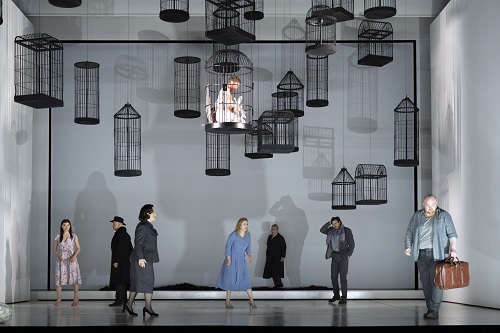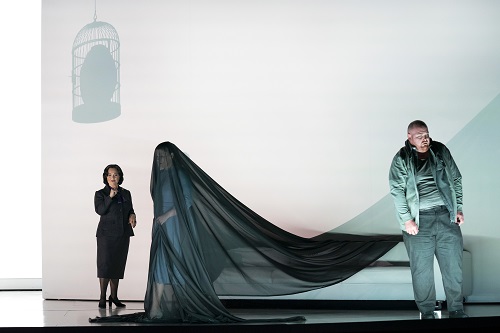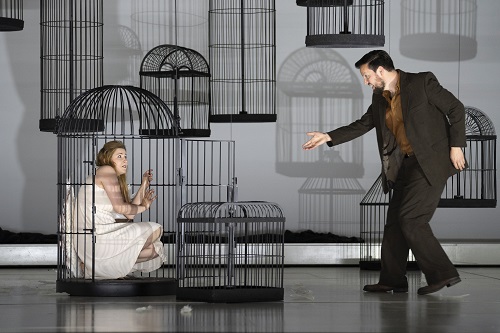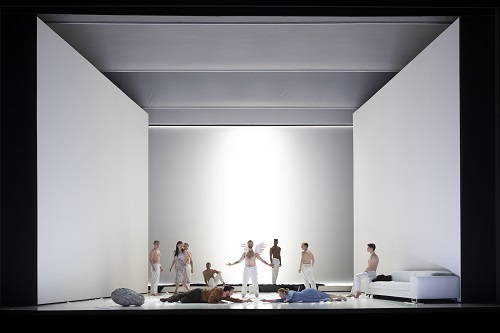“I’d go out into the garden early in the morning, just as the sun was rising, I’d fall to my knees and pray and weep, and I wouldn’t know what I was praying and weeping about, and there they’d find me.”
In Alexander Nikolayevich Ostrovsky’s 1859 realist drama, The Thunderstorm, Kát’a Kabanová’s reminiscences about the forces which shaped her childhood – nature and religion – reveal an ecstatic sensitivity which proves overwhelming. Incarcerated and abused, she longs to fly like a bird, to tend the flowers, to commune with angels. Married into an oppressive mercantile family, her natural impulses cannot be constrained. And, when she transgresses, both her own religious impulses and the social tyranny – embodied by her elder generation of her vicious mother-in-law, Kabanicha, and the money-grubbing Dikoj – demand that Kát’a must be punished. But, her suicide is also a protest against injustice. She tells Varvara, “if I get to hate the place too much no power on earth will stop me. I’ll jump out of the window, throw myself in the Volga. If I don’t want to live here, I won’t, whatever they do to me.”
If it’s true that in changing the title of Ostrovsky’s play – which transplanted some of the grimmer aspects of 19th-century Russian society onto the theatrical stage and held them up to critical scrutiny – Leoš Janáček shifted the focus from some of the wider issues onto the personal tragedy of the heroine, then in the opera there is still a balance between the realism of the social milieu and the expressionistic intensity of Kát’a psychological torment and fracture. When Dikoj organises the search party and carries in Kát’a’s drowned corpse at the close, it is clear where the true guilt lies.

Glyndebourne Productions Ltd. Photo: Richard Hubert Smith
In Damiano Michieletto’s new production at Glyndebourne, there is little sense of the immediate environment which is just as significant a factor in Kát’a’s psychological unravelling as her own soul-destroying passions – sensual and spiritual. There is no external social world; only set designer Paolo Fantin’s white walls and empty bird cages, affectingly lit by Alessandro Carletti to convey atmosphere, motivation, emotion and the passing of time, through shape-shifting shadows and muted pastel radiations. There is a white sofa which suggests domesticity, but which is out of place in the garden scenes, in which it is a pitiful replacement for the beauty in nature of which Kát’a dreams. The oppressive panels slide and twist to offer glimpses of a freedom beyond their confines; yet, this ‘release’ is a glaring white light, stark, unsettling, unconsoling. The panels press inwards, stifling and threatening. Michieletto envisages Janáček’s opera as a theatrical declaration: ‘I Know Why the Caged Bird Sings’.
We are inside Kát’a’s mind and soul. Oddly, though, these interiorities are made accessible and tangible, for the symbolic is writ large. The results are thought-provoking but not wholly satisfactory. A falling feather – like Emily Dickinson’s ‘hope’, sweetest in the storm, a little bird which ‘kept so many warm’ – flutters within Kát’a’s grasp during the instrumental prelude. Her dreams of flight are an origami dove, which soars and then is ripped to shreds. A bird cage dangles from the flies, but what is that egg-shaped rock that it encloses – a Sisyphean burden? When Kát’a remembers those childhood angels, a muscular, winged soul-spirit duly appears … and, then, eight more such celestial spirits-made-flesh intrude, their anguished movements choreographed by Chiara Vecchi.

I presume that the angel is the embodiment of Kát’a’s soul. As she pleads with Tichon not to leave her, or at least to demand a promise from her before he departs, the angel sinks to its knees, head pressed against the white wall. The flinching of the eight dancers, beneath their caged archangel dangling above, charts her guilt and confession, hysteria and despair. The soul-angel self-mutilates his wings of hope. But, if the angels are in Kát’a’s mind, they are surely hidden from the other characters, if not from the audience? What are we to make of the Kabanicha’s spiteful plucking of the angel’s feathers during the tryst between Boris and Kát’a; or of Boris’s opening of the cage door during Kát’a’s final ecstatic transfiguration? And, pity poor Varvara and Kudrjaš, whose beautifully truthful song of love and freedom becomes a mere side show for the angels’ posturing.
And, what of the river that beckons and engulfs the tragic heroine? Well, I assume it is the black snake of gauzy cloth which wriggles across the back of the stage, carelessly tossed to the rear by Varvara and Kudrjaš. Initially it was a shroud – an emblem of the Kabanicha’s cruel, suffocating demands for Kát’a’s obedience, humiliation and self-abnegation.

© Glyndebourne Productions Ltd. Photo: Richard Hubert Smith
The mid-blue dress in which Carla Teti clothes Kateřina Kněžíková is suggestive of the Virgin Mary yet cut in a shapeless peasant style – a stark comparison to the fresh-flower speckled frock and pink stilettos of Aigul Akhmetshina’s blithe Varvara. Kněžíková conveys Kát’a’s goodness and hope, anguish and guilt, with vocal and physical precision and intensity. Every phrase is nuanced and considered, but entirely natural. Her pianissimos are crystalline, transcending suffering. The final scene, in which Kát’a imagines the birds singing on her grave, is somehow both uplifting and heart-wrenching.

David Butt Philip is a fine Boris, singing with characteristic commitment and strength. And, if the need for social distancing on stage robs the romance of some of its passion, then it is an apt reminder that Boris’s inadequacy is part of Kát’a’s tragedy. Nicky Spence also throws his all into his portrait of Tichon as a hip-flask swigging mummy’s boy who wants to do the right thing for the women he loves but whose neurotic weakness trumps any good intentions. Spence’s characterisation is both painful to watch and beautiful to hear. Thomas Atkins’ ebullient Kudrjaš is wonderfully engaging; no wonder Aigul Akhmetshiina’s radiant Varvara is smitten. The pair’s departure for Moscow is the one truly heartening moment of Michieletto’s production.
Katarina Dalayman’s Kabanicha, elegantly dressed, despotically evil, is hateful – and so she should be. But, her scene with Alexander Vassiliev’s drunk and would-be debauched Dikoj falls a bit flat – not because of the singing, but because the community and its flaws have been shunted into the hinterland by Michieletto. Tom Mole, recently awarded the Guildhall’s Gold Medal, does well to engage us as Kuligin, in Act 3, refuting Dikoj’s belief that the storm is a sign of divine punishment with rational scientific explanation – though Michieletto’s concept doesn’t have much room for the future social change and progress that Kuligin represents.
The Glyndebourne Chorus are heard from the wings, and they are terrific, especially in the final moments in which they summon some sense of the natural forces which lure Kát’a to her death. Indeed, their very facelessness is, paradoxically but appropriately, their power.

Robin Ticciati’s delight and joy to be back in the Glyndebourne pit conducting the reduced forces of the London Philharmonic Orchestra inform every moment of this production. Responsive to every dramatic nuance, he coaxes such delicacy, emotion, drama, through the shifts and sways of the action. If the reduced orchestration (Tony Burke) means that the strings don’t always lift one aloft, as they might, then there is insight to be gained from the refreshing clarity of the woodwind, the piercing intensity of the horns, and the painful deliberation of the timpani’s fate motif – all brought to the fore by the necessity for compromise. If I say that Ticciati emphasises the cinematic qualities of the score, this is no criticism.
Maya Angelou’s caged bird sings ‘of things unknown/ but longed for still’:
and his tune is heard
on the distant hill
for the caged bird
sings of freedom.
At the final curtain, the battered cages come crashing down but the birds are not released. Michieletto denies Kát’a her transfiguration. There is no protest, or liberation, only tragedy.
Claire Seymour
Katěrina (Káťa) – Kateřina Kněžíková, Varvara – Aigul Akhmetshina, Boris – David Butt Philip, Tichon – Nicky Spence, Kudrjaš – Thomas Atkins, Kabanicha – Katarina Dalayman, Dikoj – Alexander Vassiliev, Kuligin – Tom Mole, Gláša – Sarah Pring, Fekluša – Jessica Ouston, Woman – Bethany Horak-Hallett, Passer-by – Robert Lewis, Angel – Robin Gladwin, Dancers (Lukas Hunt, Phil Mennell, Gareth Mole, Owen Morris, Ryan Munroe, Matthew Petty,Jonathan Savage, Aaron Smith); Director – Damiano Michieletto, Conductor – Robin Ticciati, Set Designer – Paolo Fantin, Costume Designer – Carla Teti, Choreographer – Chiara Vecchi, Lighting Designer – Alessandro Carletti, London Philharmonic Orchestra, Glyndebourne Chorus (Chorus Director, Aidan Oliver)
Glyndebourne Opera, Saturday 22nd May 2021.
ABOVE: Kateřina Kněžíková (Káťa) © Glyndebourne Productions Ltd. Photo: Richard Hubert Smith